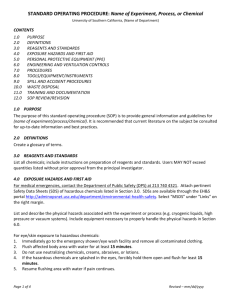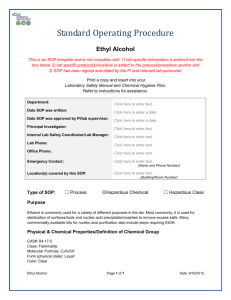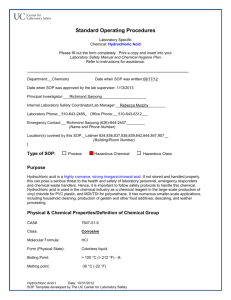Hydrochloric Acid
advertisement
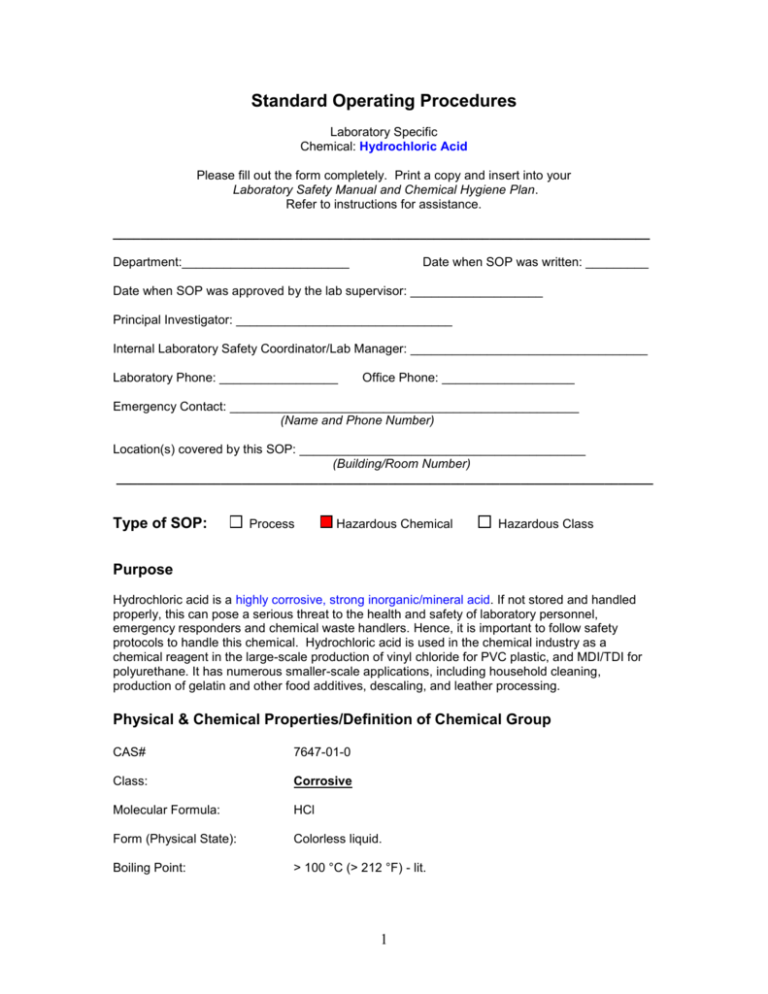
Standard Operating Procedures Laboratory Specific Chemical: Hydrochloric Acid Please fill out the form completely. Print a copy and insert into your Laboratory Safety Manual and Chemical Hygiene Plan. Refer to instructions for assistance. _____________________________________________________________________________ Department:________________________ Date when SOP was written: _________ Date when SOP was approved by the lab supervisor: ___________________ Principal Investigator: _______________________________ Internal Laboratory Safety Coordinator/Lab Manager: __________________________________ Laboratory Phone: _________________ Office Phone: ___________________ Emergency Contact: __________________________________________________ (Name and Phone Number) Location(s) covered by this SOP: _________________________________________ (Building/Room Number) _____________________________________________________________________________ Type of SOP: Process Hazardous Chemical Hazardous Class Purpose Hydrochloric acid is a highly corrosive, strong inorganic/mineral acid. If not stored and handled properly, this can pose a serious threat to the health and safety of laboratory personnel, emergency responders and chemical waste handlers. Hence, it is important to follow safety protocols to handle this chemical. Hydrochloric acid is used in the chemical industry as a chemical reagent in the large-scale production of vinyl chloride for PVC plastic, and MDI/TDI for polyurethane. It has numerous smaller-scale applications, including household cleaning, production of gelatin and other food additives, descaling, and leather processing. Physical & Chemical Properties/Definition of Chemical Group CAS# 7647-01-0 Class: Corrosive Molecular Formula: HCl Form (Physical State): Colorless liquid. Boiling Point: > 100 °C (> 212 °F) - lit. 1 Melting point: -30 °C (-22 °F) Density: Odor: 1.2 g/cm3 at 25 °C (77 °F) Pungent Synonym: Muriatic acid Potential Hazards/Toxicity Pictogram Potential Health Effects Inhalation May be harmful if inhaled. Material is extremely destructive to the tissue of the mucous membranes and upper respiratory tract. Skin May be harmful if absorbed through skin. Causes skin burns. Eyes Causes eye burns. Ingestion May be harmful if swallowed. Signs and Symptoms of Exposure Burning sensation, cough, wheezing, laryngitis, shortness of breath, spasm, inflammation and edema of the larynx, spasm, inflammation and edema of the bronchi, pneumonitis & pulmonary edema. Material is extremely destructive to tissue of the mucous membranes and upper respiratory tract, eyes, and skin. Personal Protective Equipment (PPE) Respiratory protection Respirators should be used only under any of the following circumstances: As a last line of defense (i.e., after engineering and administrative controls have been exhausted). When Permissible Exposure Limit (PEL) has exceeded or when there is a possibility that PEL will be exceeded. Regulations require the use of a respirator. An employer requires the use of a respirator. There is potential for harmful exposure due to an atmospheric contaminant (in the absence of PEL) As PPE in the event of a chemical spill clean-up process Lab personnel intending to use/wear a respirator mask must be trained and fit-tested by EH&S. This is a regulatory requirement. (http://map.ais.ucla.edu/go/1004655) Hand protection Type of gloves recommended for Hydrochloric acid: Nitrile Note: Consult with your preferred glove manufacturer to ensure that the gloves you plan on using are compatible with Hydrochloric acid. Eye protection 2 Type of eye protection used to handle the chemical: Splash goggles. If used in large quantities, please use appropriate face shield. Skin and body protection Lab coat, long pants, closed-toed shoes Hygiene measures Avoid contact with skin, eyes and clothing. Wash hands before breaks and immediately after handling Hydrochloric acid. Engineering Controls All operations involving Hydrochloric acid must be carried out in a certified chemical fume hood (certified once every year by EH&S). Laboratory rooms must be at negative pressure with respect to the corridors and external environment. To achieve this, the laboratory/room door must be kept closed at all times. First Aid Procedures General advice Consult a physician. Show this safety data sheet to the doctor in attendance. Move out of dangerous area. If inhaled If breathed in, move person into fresh air. If not breathing, give artificial respiration. Consult a physician. In case of skin contact Take off contaminated clothing and shoes immediately. Wash off with soap and plenty of water for at least 15 minutes. Consult a physician. In case of eye contact Rinse thoroughly with plenty of water for at least 15 minutes and consult a physician. Continue rinsing eyes during transport to hospital. If swallowed Do NOT induce vomiting. Never give anything by mouth to an unconscious person. Rinse mouth with water. Consult a physician. Special Handling and Storage Requirements Precautions for safe handling Avoid contact with skin and eyes. Avoid inhalation of vapor or mist. Always use inside a chemical fume hood. Note: In case you need to dilute the concentration of HCl, always add acid to water. Always transfer from container to the receptacle by using an appropriate funnel. DO NOT mouth-pipette HCl. Conditions for safe storage Do not store in/with combustible packing material; such as cardboard, Styrofoam, plastic and paper. Keep container upright & tightly closed in a dry and well-ventilated place. Containers which are opened must be carefully resealed and kept upright to prevent leakage. Always store HCl in a secondary container. Note: Nalgene/polypropylene tray or a tub is the best suited secondary containment. 3 Materials to avoid: Store segregated from – Organic Acids, Bases, Amines, Alkali metals, Metals, permanganates, e.g. potassium permanganate, sodium hypochlorite (bleach), Fluorine, metal acetylides, hexalithium disilicide. Spill and Accident Procedure Personal precautions Use Personal Protective Equipment (PPE). Avoid breathing vapors, mist or gas. Ensure adequate ventilation. Evacuate personnel to safe areas. Environmental precautions Do not let product enter drains. NOTE: Always have a chemical spill kit fully stocked and easily accessible at all times. Chemical Spill Dial 911 and x59797 Spill – Help contaminated or injured persons. Evacuate the spill area. Avoid breathing vapors. Eliminate sources of ignition if the chemical is flammable. If possible, confine the spill to a small area using a spill kit or absorbent material. Keep others from entering contaminated area (e.g., use caution tape, barriers, etc.). Small (<1 L) – If you have training, you may assist in the clean-up effort. Use appropriate personal protective equipment and clean-up material for chemical spilled. Double bag spill waste in clear plastic bags, label and take to the next chemical waste pick-up. Large (>1 L) – Dial 911 (or 310-825-1491 from cell phone) and EH&S at x59797 for assistance. Chemical Spill on Body or Clothes – Remove clothing and rinse body thoroughly in emergency shower for at least 15 minutes. Seek medical attention. Notify supervisor and EH&S at x59797 immediately. Chemical Splash Into Eyes – Immediately rinse eyeball and inner surface of eyelid with water for 15 minutes by forcibly holding the eye open. Seek medical attention. Notify supervisor and EH&S at x59797 immediately. Medical Emergency Dial 911 or x52111 Life Threatening Emergency, After Hours, Weekends And Holidays – Dial 911 (or 310-825-1491 from cell phone) or contact the Ronald Reagan UCLA Medical Center (emergency room) directly at x52111 (located at 757 Westwood Plaza, enter from Gayley Avenue). Note: All serious injuries must be reported to EH&S at x59797 within 8 hours. Non-Life Threatening Emergency– Go to the Occupational Health Facility (OHF), x56771, CHS room 67-120 (This is on the 6th floor, 7th corridor, room 120. Enter through the School of Dentistry on Tiverton Drive and proceed to the “O” elevator to the 6th floor.)Hours: M F, 7:30 a.m. to 4:30 p.m. At all other times report to Ronald Regan UCLA Medical Center (emergency room) at x52111. Note: All serious injuries must be reported to EH&S at x59797 within 8 hours. 4 Needle stick/puncture exposure (as applicable to chemical handling procedure)– Wash the affected area with antiseptic soap and warm water for 15 minutes. For mucous membrane exposure, flush the affected area for 15 minutes using an eyewash station. Page the needle stick nurse by dialing 231 from a campus phone, enter 93333 when prompted and then enter your extension. Hours: M – F, 8:00 a.m. to 4:00 p.m. At all other times report to Ronald Regan UCLA Medical Center (emergency room) at x52111. Note: All needle stick/puncture exposures must be reported to EH&S at x59797 within 8 hours. Decontamination/Waste Disposal Procedure Wearing proper PPE, please decontaminate equipment and bench tops using soap and water. Please dispose of the spent hydrochloric acid and disposables contaminated with hydrochloric acid as hazardous waste. General hazardous waste disposal guidelines: NOTE: Segregate acid waste containers from base waste containers. Label Waste Affix an on-line hazardous waste tag on all waste containers using the Online Tag Program http://otp.ucop.edu/ as soon as the first drop of waste is added to the container Store Waste Store hazardous waste in closed containers, in secondary containment and in a designated location Double-bag dry waste using transparent bags http://map.ais.ucla.edu/go/1002774 Waste must be under the control of the person generating & disposing of it Dispose of Waste Dispose of regularly generated chemical waste within 90 days Call EH&S at x61887 for questions Empty Containers o Dispose as hazardous waste if it once held extremely hazardous waste (irrespective of the container size) http://ehs.ucla.edu/Pub/ExtremelyHazardousWaste.pdf o Consult waste pick-up schedule http://ehs.ucla.edu/pub/HazWaste%20Pickup%20Schedule.pdf Prepare for transport to pick-up location Check on-line waste tag Write date of pick-up on the waste tag Use secondary containment Safety Data Sheet (SDS) Location (State the location of SDS) Hardcopy or electronic copy must be available. Online SDS can be accessed at http://msds.ehs.ucla.edu. Protocol/Procedure (Add specific description of procedure) NOTE Any deviation from this SOP requires approval from PI. 5 Documentation of Training (signature of all users is required) The Principal Investigator must provide his/her laboratory personnel with a copy of this SOP and a copy of the SDS provided by the manufacturer. The Principal Investigator must ensure that his/her laboratory personnel have attended appropriate laboratory safety training or refresher training within the last one year. I have read and understand the content of this SOP: Name Signature Date ________________________________ ____________________________ ____________ ________________________________ ____________________________ ____________ ________________________________ ____________________________ ____________ ________________________________ ____________________________ ____________ ________________________________ ____________________________ ____________ ________________________________ ____________________________ ____________ ________________________________ ____________________________ ____________ ________________________________ ____________________________ ____________ ________________________________ ____________________________ ____________ ________________________________ ____________________________ ____________ ________________________________ ____________________________ ____________ ________________________________ ____________________________ ____________ ________________________________ ____________________________ ____________ ________________________________ ____________________________ ____________ ________________________________ ____________________________ ____________ ________________________________ ____________________________ ____________ ________________________________ ____________________________ ____________ ________________________________ ____________________________ ____________ ________________________________ ____________________________ ____________ ________________________________ ____________________________ ____________ 6

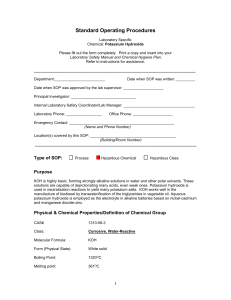
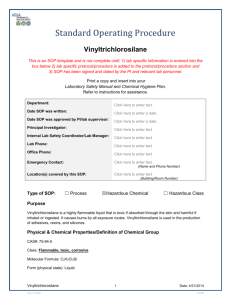
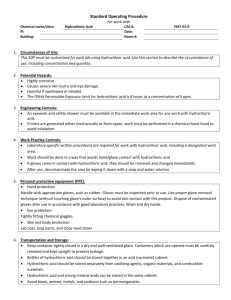
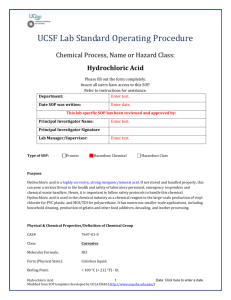
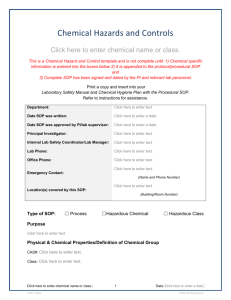
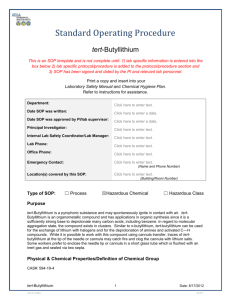
![2-Amino-3,8-dimethylimidazo[4-5-f]quinoxaline (MeIQx)](http://s3.studylib.net/store/data/007382552_1-550cb77a81c5a136078f91aa233fba55-300x300.png)
